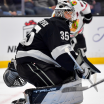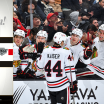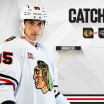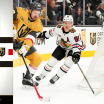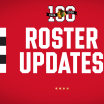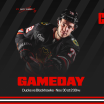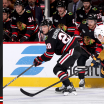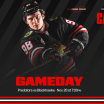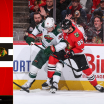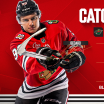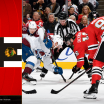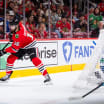How does a team like the Blackhawks respond when their margin of error has shrunk down to nothing, when plans A, B and C have been swallowed up in a 3-0 series deficit to a Nashville team that not only has all the answers but has shown its work?
Game 4, which takes place Thursday evening inside a hostile Bridgestone Arena that will again be aggressively daubed with canary yellow, will provide an answer that could have long-term impact whether the Blackhawks win or lose.
Win, and the team goes back to Chicago with an opportunity to make things right with the home crowd, which was last seen expressing their displeasure throughout the last half of Game 2.
Lose, and the team goes back to Chicago to face another long summer.
"The pressure is on them" seems to be the prevailing attitude in the Blackhawks' locker room, but that's not to say there isn't also an enormous amount of pressure on the Western Conference's top seed entering a do-or-die Game 4.
If Wednesday's practice was any indication, Head Coach Joel Quenneville will most likely run the same forward groupings on Thursday, although he may make a change on the back end after Michal Kempny took veteran Johnny Oduya's spot in practice on Wednesday. If Kempny does make the lineup for Game 4, it would mark the 26-year-old's Stanley Cup Playoffs debut, one that comes with a heavy load given what's at stake.
Buzz: No more margin for error for Blackhawks in Game 4

In Monday's 3-2 comeback victory in overtime by the Predators, the Blackhawks could not maintain early momentum for a third straight game, getting doubled in first-period shots (18-9). A massive effort by Corey Crawford kept his team in the game until the second period, when the third line finally found twine for Chicago's first goal of the series.
The trio of Marcus Kruger, Dennis Rasmussen and Richard Panik were the Blackhawks' most effective line on Monday and were responsible for creating the first goal of the game after Kruger found Rasmussen from behind the goal line for a quick backhand attempt that evaded Pekka Rinne.
"I think we supported each other on the forecheck and tried to get big bodies in front of the net, and that's what we have to do every game," Rasmussen said. "It doesn't really matter who's stepping up -- everyone's got to do it now."
Indeed, aside from the third line, Crawford's overall performance and an inspired outing from Patrick Kane -- a postseason career-high 9 shots on goal and the Blackhawks' second tally -- there weren't many positives, especially in the third period and overtime. The Preds, on the other hand, looked stronger as the game progressed, especially their lethal top line of Ryan Johansen, Viktor Arvidsson and Filip Forsberg. The latter tallied both of Nashville's regulation goals, capitalizing on some fortuitous bounces that weren't defended especially well by the visitors.
As Quenneville noted, the onus is on the Blackhawks to shut down Nashville's top line, and they simply haven't gotten it done so far.
"They were opportunistic on their goals, but I still think they're all defendable on our part," he said on Tuesday, a much-needed off day for the team. "That's what made it tough. That line, they've got quick sticks, some quickness, and they're on a good roll the last part of the year. We've got to try to shut it down."
That will be difficult, as Nashville has had a visible edge over Chicago all series in overall team speed. The Preds have not only been able to turn defense into offense at the drop of a hat, they've managed to be the first to get to loose pucks, especially in dangerous areas. While the Blackhawks aren't a slow team, the Preds have in some cases been able to skate circles around them. Quenneville wants his team to turn the tables.
"I think we can be more influential, whether it's making them defend or cornering people quicker," he said. "I still think we're a fast team, and we can be faster."
Team speed requires a complete buy-in from forwards and defensemen alike, as the Predators have shown. Although Ryan Ellis picked up the lone point for Nashville's blue line in Game 3, a combined 34 shot attempts (out of 79, or 43 percent of the team total) neatly illustrates the pressure they've been able to apply the offensive zone.
"Give them credit, they're mobile, they're active, their [defensemen] are very supportive of their attack," Quenneville said. "They've had the puck a lot in the offensive zone as well. Their team gap has been very tight through the neutral zone, they're playing patient, they're not looking to give up rush chances. Give them credit, but I still think there's room for growth."



